Making Invisible Histories Visible
Page Navigation
- Making Invisible Histories Visible
- Lesson Plans and Resources
- iBooks on Omaha and Nebraska History for Primary Students
- Omaha Mapping Projects
-
African American Histories
- African American Artists
- African American Athletes & Facilities
- African American Churches
- African American Civil Rights Organizations - 1950s-1960s
- African American Civil Rights
- African American Contributions to Jazz, Gospel, Hip-Hop
- African American Dramatic Arts
- African American Education - Dorothy Eure & Lerlean Johnson
- African American Educators & Education
- African American Firefighters
- African American Homesteaders
- African American Law Enforcement
- African American Migration to Omaha
- African American Musicians of Omaha
- African American Newspapers
- African American Owned Businesses
- African American Politicians
- African American Social Life
- African American Workers at Omaha's Railroads & Stockyards
- African American Workers at the Naval Ammunition Depot in Hastings
- African Americans in the Civil War
- African Americans in Vietnam
- Charles B. Washington - Journalist and Civil Rights Leader
- Elizabeth Davis Pittman - Lawyer/Judge
- Green Book Omaha
- Marlin Briscoe - Professional Football Player
- Native Omaha Days
- Nebraska's Role in the Underground Railroad
- Sen. Edward Danner - Politician & Civil Rights Activist
- Sudanese Refugees
- Tuskegee Airmen
- European and Asian Immigrant Histories
-
Historic Neighborhoods & Buildings
- 24th and Binney/Wirt/Spencer Streets
- 24th and Lake Streets
- Central Park Neighborhood - 42nd and Grand Avenue
- Dahlman Neighborhood - 10th and Hickory Streets
- Hartman Addition Neighborhood - 16th and Williams Streets
- Indian Hills/Southside Terrace Neighborhood - 30th and Q Streets
- Jefferson Square Neighborhood - 16th and Chicago Streets
- Long Neighborhood - 24th and Clark Streets
- Orchard Hill Neighborhood - 40th and Hamilton Streets
- Smithfield Neighborhood - 24th and Ames Avenue
- St. Mary's Neighborhood - 30th and Q Streets
- Latino Histories
- Music Histories
-
Native American Histories
- Black Elk and John G. Niehardt
- Chief Standing Bear and Susette La Flesche Tibbles
- Dr. Susan LaFlesche Picotte - Native American Doctor
- Native American Education and Boarding Schools
- Native Americans in the Military
- Pre-statehood Interaction of Native Americans and Europeans
- Preserving Native American Tradition
- Restoring the Ponca Tribe
- The American Indian Movement in the 1960s and 1970s
- The Indian Congress at the 1898 Trans-Mississippi Exposition
- The Omaha Native American Indian Tribe
- OPS Elementary School History
- Redlining in Omaha
- Nebraska's Role in the Underground Railroad
- The 1898 Trans-Mississippi Exposition
African American Newspapers
-
African American newspapers have provided many services in Omaha. What are some of the most important?
"No One Can Tell Our Story Like We Can." - Dr. Marguerita Washington
African-American Newspapers in Omaha
-
Throughout our history, African Americans have struggled to be treated fairly and to be free. Segregation and discrimination followed African Americans as they moved from the South to the North during the 20th century, leading to the fight for civil rights. African American newspapers in Omaha provided a voice. During the period of the Great Migration, African American newspapers, like the Omaha Monitor, worked to get the truth out about discrimination and racial injustice. Between WWI and WWII, African American newspapers, such as the Omaha Guide, strove to show African Americans in a positive light, and continued to promote movement North for new opportunities. In the post-WWII era, civil unrest shaped many African American communities. Newspapers like the Omaha Star provided a strong and positive voice for the African American community, fought for civil rights, promoted the good within, and encouraged people to make a difference.
A 7 minute video produced in 2011 interviewing Dr. Marguerita Washington, Mildred Brown's niece. Washington took over running the Omaha Star in 1989.
Early Omaha Newspapers
-
Since the 1890s, African American newspapers have existed in Omaha. The purpose of the African American newspapers was to give African Americans pertinent information and hope. In 1922, The Monitor published the article, “Omaha's Colored Citizenry Alive and Progressive” to promote the African American community. The article featured information about activities and current events such as churches, clubs, lodges, and other organizations, which demonstrated the liveliness of the community. By showing that African Americans made up six percent of the population and owned property worth $2.5 million, The Monitor persuaded African Americans to settle in Omaha during the Great Migration.
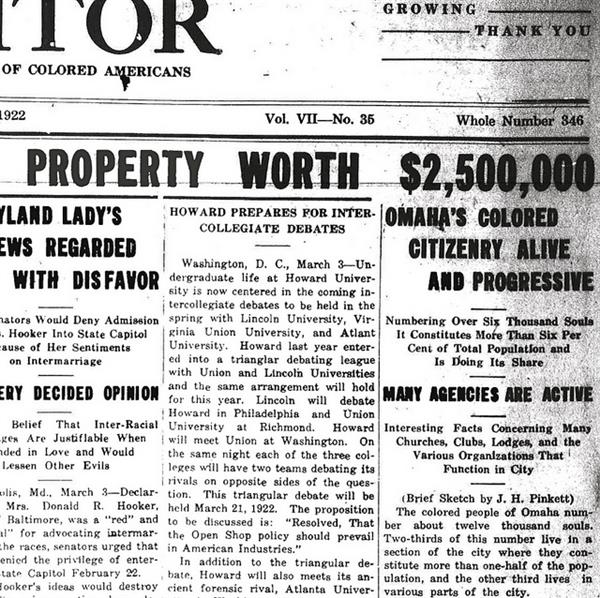
The Omaha Star
-
The Omaha Star is the oldest Black-owned business in Omaha, continuously in operation since Mildred Brown founded the paper in 1938. The paper has been located at 2216 N. 24th St. for all of its 73 years. In 2011, Brown's niece, Dr. Marguerita Washington, ran the weekly newspaper with more than 30,000 subscribers in all 50 states.
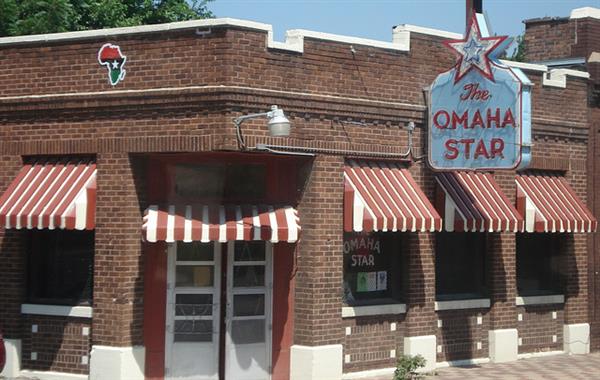
The Omaha Star has been located at 2216 North 24th Street for all of its 73 years.
Family of the Week
-
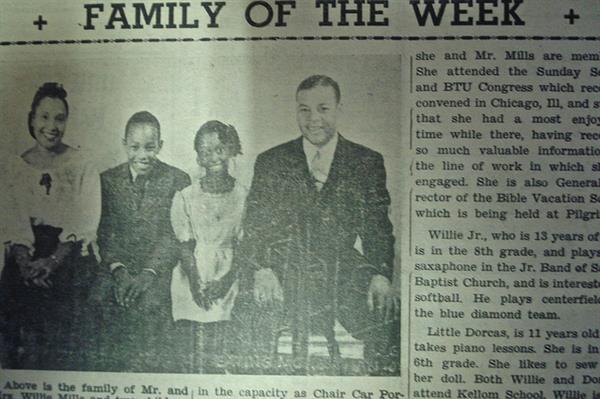
Throughout their history, African American newspapers sought to connect people of the community by reporting on its events, and promoting its members in a positive light. African American newspapers often avoided reporting crimes, so as not to show the community in a negative way. In the past, The Omaha Star newspaper promoted the community with a “Family of the Week” section. This lighthearted section involved facts about the family and discussed why they were chosen. Today, African American newspapers still provide a voice for the community, covering stories important to African Americans, and bringing attention to the good going on in the community.
History of the Omaha Star
-
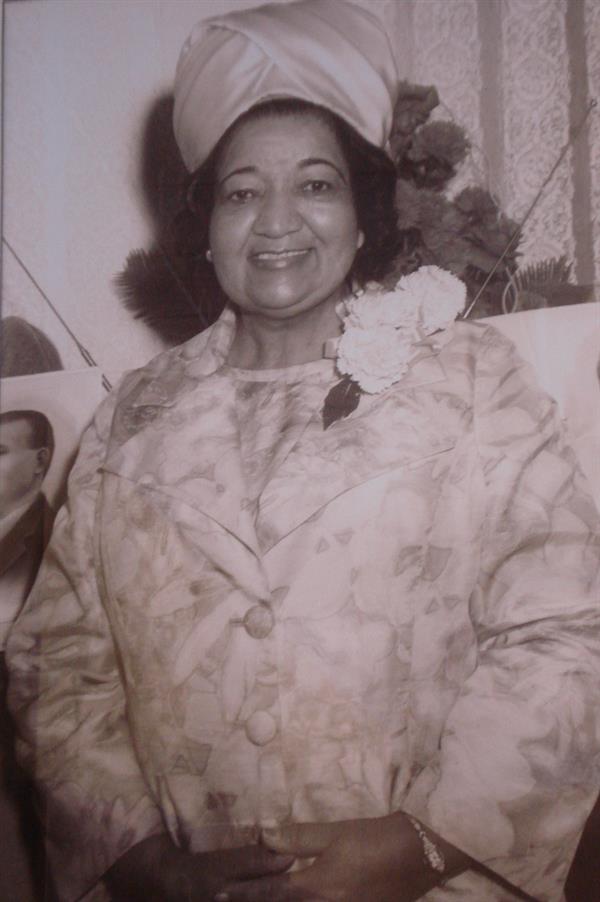
Mildred Brown, the founder of The Omaha Star, was born in Bessemer, Alabama. She moved from Alabama to Sioux City, and started her first newspaper. Later, she moved to Omaha to work for the Omaha Guide. In 1938, she decided to start her own newspaper and The Omaha Star was born. Brown started The Omaha Star so African Americans could have a voice in the community and to give hope. Brown wanted the paper to provide a positive outlook on events in the African American community; other media at the time only reported negative stories related to African Americans. Additionally, segregation in Omaha and nationwide wore down people's hope; the paper worked to uplift the community during challenging times. (Photo from The Omaha Star)
School Board
-
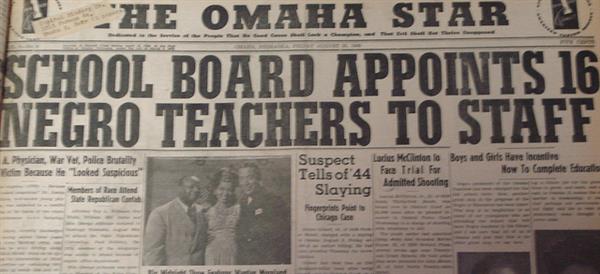
Segregation, discrimination, and racism were not just southern issues; they were alive in the North as well. In Omaha, newspapers such as The Monitor and The Guide helped to bring attention to these issues in the early 20th century; by the late 1930s, The Omaha Star also was fighting the fight. The Omaha Star was the voice of the African American community and was involved in the civil rights movement, fighting discrimination and racial injustice. One of their battles was getting African American teachers hired for Omaha Public Schools. During the civil rights era, some leaders within Omaha Public Schools thought African Americans were not qualified to be teachers and only let them teach in predominantly African American schools. This article from 1946 represents how The Omaha Star brought attention to this injustice, and ultimately won the battle they had been fighting for a long time. Both in the past and in the present, African American newspapers play a large role in voicing the concerns of the community.
Additional Information
-
The African American press in the United States has long provided a voice for the African American community, focusing on issues of concern and celebrating African Americans’ achievements. African American newspapers in Omaha have done the same since the late 1800s. The papers changed over time but always gave a voice to the community, fighting against discrimination and racial injustice, as well as presenting a positive image of the community.
Early African American papers in the late 19th and early 20th centuries, like Omaha’s Progress, Enterprise, Monitor, and New Era, supported the enforcement of civil rights laws and the migration of African Americans to northern states. The papers also countered the often-negative portrayal of African Americans found in the white press by presenting a positive image of African Americans, showing their contributions to their community and the city as a whole. Like many other early African American papers, Omaha’s papers struggled to secure advertisers and could not survive on subscribers alone.
In the mid-20th century, African American newspapers, like the Omaha Guide, continued to promote a positive image of the African American community by including community social information and stories on prominent African American visitors to Omaha. The paper also continued to fight discrimination. The Guide, like other African American papers, denounced discriminatory employment in the defense industry and the military during WWII.
Omaha’s longest running African American paper, The Omaha Star, was founded in the late 1930s with the goal of providing uplift and a positive image of the African American community. Like many African American papers of the era, The Star played an important role in the civil rights movement, reporting on national activities and fighting for local issues like open occupancy, school desegregation, and African American representation on the city council and school board. While the mainstream media includes more stories about Omaha’s African American community, The Omaha Star remains active, providing the community with its own voice and highlighting the positive activities of Omaha’s African American community.
2011 MIHV Project
Student Reflections
-
"I came to this camp not knowing much about African-American history, or much about their community, now I will leave with more knowledge than what I came with. When I thought of North Omaha's neighborhood, it was a bad area to be around. That's why I did not want to go down in that particular area. Now that I did this summer camp it has brought out the positive side of the North Omaha neighborhood. This is a once-in-a-lifetime experience to learn more about North Omaha's history. With all of the guests and speakers we've had, it helps put you in their place when you hear their stories and background of their own history."
- Kristen J.
"I did not understand North Omaha very well before this camp. After this camp I learned what North Omaha use to be, it made me realize it was a very interesting place and was so much more than it is today."- McKenzie C.
Resources
-
"Education Study Guide." The Black Press: Soldiers without Swords.1999. https://www.pbs.org/blackpress/film/index.html.
Forss, Amy. “Mildred Brown and the Omaha Star, 1938-1989.” Nebraska History, 2010.
PAZ, D.G. "The Black Press and the Issues of Race, Political, and Culture on the Great Plains of Nebraska, 1865-1985." In The Black Press in the Middle West, 1865-1895, edited by Henry Lewis
Suggs, 213-241. Contributions in Afro-American and African Studies No. 177. Westport, CT: Greenwood Press, 1996.
The Nebraska State Historical Society holds bound volumes of many of Omaha's African-American newspapers. The Omaha Public Library Main Downtown Library has many of Omaha's African-American newspapers on micro-film.
Created by: McKenzie C., Kristen J., Lindsay B., and Catherine M.

